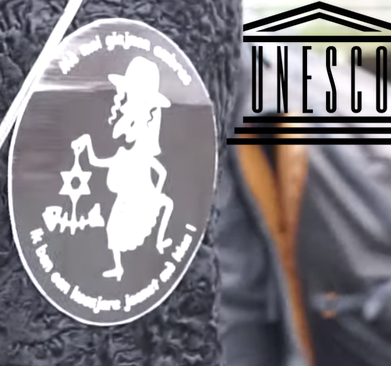A New Lease on Life for the "Jewish Nose" Lie

Few people are shocked when a drunken buffoon or a white supremacist rants about Jews having distinctive noses. But when a historian at a respected institution perpetuates that dangerous myth, it’s a cause for concern.
In a tweet on December 17, 2019, Dr. Rebecca Erbelding, a staff historian at the United States Holocaust Memorial Museum, who frequently represents it at events around the country, wrote: “At a talk today, asked about my personal background. I confessed that I’m not Jewish, but with a Hebrew first name, German last name, and my nose and hair, I ‘pass’.”
The same week that Erbelding made her remark, UNESCO announced that it was canceling its association with the annual Carnival of Aalst, in Belgium, because the carnival has included a float that mocked Jews by depicting them with huge “Jewish noses.”
Perhaps Erbelding or the Belgian float designers believed they were acting in a humorous spirit. But that misses the point. Wrapping a racist stereotype in a joke does not make it any less racist. It does the same damage—it perpetuates the degradation of the Other. The idea that there is a distinctive “Jewish nose” is one of the oldest anti-Jewish myths. Medieval anti-Semites introduced it in the 12th century CE as a way of singling out Jews for contempt. The nose became “a physical symbol of otherness for Jews,” as Prof. Roy Goldblatt has put it.
Nazi Germany’s propaganda machine made ample use of the “Jewish nose” stereotype. A notorious Nazi film produced in 1940, called “The Eternal Jew,” purporting to expose the “real” Jew, focused on “Jewish faces,” zooming in on Jews’ noses to make them seem unattractive.
Similar images appeared throughout the Nazis’ news media, cultural publications, and children’s books. Der Giftpilz, an anti-Jewish children’s book published by Julius Streicher (publisher of the Nazi newspaper Der Sturmer), included a section called “How To Tell A Jew.” It described a 7th grade boys’ class, in which “Karl Schulz, a small lad in the front row,” steps to the chalkboard and declares: “One can most easily tell a Jew by his nose. The Jewish nose is bent at its point. It looks like the number six. We call it the ‘Jewish six.’ ”
In recent years, the “Jewish nose” lie has been heard from time to time. In 1999, for example, Arizona state legislator Barbara Blewster told a colleague, “You can’t be Jewish. You don’t have a big hooked nose.” Blewster was compelled to publicly apologize, but she continued to insist, “I have no prejudice at all. I admire the Jews.”
The recently resigned prime minister of Malaysia, Mahathir Mohamed, has repeatedly referred to “hook-nosed Jews.” The website of Belgium’s Ghent University until recently included a sign-language video showing a hooked nose as the translation for the word “Jewish.”
A related episode occurred in Sweden last year. A Jewish woman reported that when she went to a Stockholm police station to have her photo taken for an ID card, an antisemitic officer digitally altered her image to drastically enlarge her nose.
Women in particular have suffered from the “Jewish nose” stereotype. Rachel Jacoby Rosenfield and Maital Friedman, of the Shalom Hartman Institute, have written about how the “Jewish nose” and similar stereotypes have been used to intimidate Jewish women into altering their appearances. “These negative stereotypes have impacted our Jewish psyche and spawned a self-consciousness and communal shame about ‘Jewish looks’,” they point out.
Some scholars see a connection between the Jewish nose stereotype and violence against Jews. In a recent essay, Jonathan Kaplan of the University of Technology-Sydney, noted that Pittsburgh synagogue gunman Robert Bowers invoked classic anti-Jewish stereotypes in his online ravings. “How we speak about and depict others in the media and social discourse perpetuates long-held stereotypes and ultimately emboldens hate-filled individuals,” Kaplan warned.
That, in my view, is what makes the Jewish nose lie so dangerous, and why it is so important for mainstream society to reject it. Stereotypes fuel hatred. Hatred fuels violence. So even when a stereotype is invoked in a supposedly humorous way, it has the same impact.
In fact, one could argue that a racist “joke” is even more insidious than the kind that is yelled at a passerby or scrawled on the side of a synagogue. Anti-Semitic humor helps bigotry infiltrate mainstream culture and discourse. Humor becomes the channel through which otherwise unacceptable sentiments are deemed acceptable.
Similarly, when a representative of a major Holocaust museum perpetuates the myth of the “Jewish nose,” it’s much more damaging than when some drunk at a local bar spouts off about Jewish noses. A scholar gives legitimacy to the stereotype in a way that the average gutter bigot never could.
Scholarly and cultural organizations, institutions, and museums need to respond swiftly when such stereotypes rear their ugly heads. UNESCO did the right thing in dissociating itself from the “Jewish nose” stereotypes of the Belgian carnival. Other institutions should do likewise.